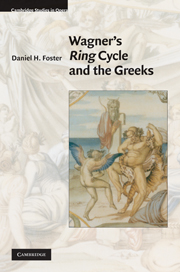Book contents
- Frontmatter
- Contents
- List of musical examples
- Preface
- Acknowledgments
- Introduction
- Part I Epic
- 1 Introduction: what is epic?
- 2 Retrospective narrative and the epic process
- 3 The orchestral narrator and elementary epic
- 4 Spiritual and factual realities in epic
- Part II Lyric
- Part III Drama
- Epilogue: Time, the Ring, and Performance Studies
- Appendices: Wagner's primary and secondary sources
- Notes
- Bibliography
- Index
3 - The orchestral narrator and elementary epic
from Part I - Epic
Published online by Cambridge University Press: 07 May 2010
- Frontmatter
- Contents
- List of musical examples
- Preface
- Acknowledgments
- Introduction
- Part I Epic
- 1 Introduction: what is epic?
- 2 Retrospective narrative and the epic process
- 3 The orchestral narrator and elementary epic
- 4 Spiritual and factual realities in epic
- Part II Lyric
- Part III Drama
- Epilogue: Time, the Ring, and Performance Studies
- Appendices: Wagner's primary and secondary sources
- Notes
- Bibliography
- Index
Summary
Like other nineteenth-century artists, but perhaps especially novelists, Wagner participated in the general trend of rejuvenating his chosen medium by infusing it with epic. This meant infusing not only his libretto but also his music with epic, a claim that few scholars have taken seriously. Previous studies of narrative in Wagner's operas have tended to stop short of discussing the ways in which his most famous musical technique, the so-called leitmotif technique, might be connected with his interest in epic. Instead, they have focused their narrative analyses almost solely on the Ring's libretto. But as Dahlhaus and Deathridge point out (but do not pursue) in The New Grove Wagner, “One might well speak of the birth of the leitmotif technique out of the dialectic of the epic element in Wagner's drama.” Indeed, beyond just finding a causal link between epic and music in Wagner, focusing on the epic properties of Wagner's leitmotifs in greater detail may also help us to arrive at a fuller understanding of the Ring's use of Greek epic forms to help define German national identity. Specifically, the way in which Wagner's emulation of epic leads him to compress music so tightly as to reduce its temporal dimension and make it seem almost spatial. With these spatialized and easily memorized leitmotifs, Wagner tries to teach his German audience what they are and what they should be: a people that values love above power.
- Type
- Chapter
- Information
- Wagner's Ring Cycle and the Greeks , pp. 65 - 82Publisher: Cambridge University PressPrint publication year: 2010



